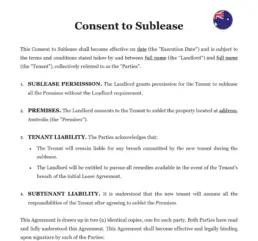Ready to use legal template
Drafted by experienced lawyers
Compliant with Australian law
Ready to use legal template
Drafted by lawyers
Compliant with Australian law
Home › Rent your property › Consent to sublease
Learn more about Consent to Sublease in Australia
In Australia, a Consent to Sublease Letter serves as a vital legal document that facilitates the subleasing of a property from a tenant to a subtenant. This letter formally requests the landlord’s permission for the tenant to sublet the premises to another party. It is mandatory for tenants to obtain this consent before signing a Sublease Agreement and engaging in any subleasing arrangements to ensure compliance with lease agreements and legal requirements. To streamline this process, we offer an easy-to-edit legal template meticulously drafted by legal experts, ensuring full compliance with Australian laws and regulations.
Table of contents
What is a Consent to Sublease Letter?
How does a Consent to Sublease ensure legal compliance in Australia?
What are the necessary steps before a Tenant sublet a property??
Is it mandatory to receive a landlord's consent letter before subleasing?
What are the rights of each party when subleasing in Australia?
When should a Consent to Sublease Letter be sent to the Tenant?
What are the risks of subletting without prior consent in Australia?
What is a Consent to Sublease Letter?
A Consent to Sublease is a formal agreement wherein a landlord grants permission to a tenant to sublease the leased premises to a third party, known as the subtenant or sublessee. This consent is essential because it ensures that all parties involved are aware of and agree to the subleasing arrangement. From the landlord’s perspective, granting consent allows them to maintain control over who occupies their property, ensuring that the subtenant meets their standards and obligations. For the tenant, obtaining consent is crucial to avoid breaching the terms of their lease agreement, which may prohibit subleasing without permission. Additionally, consent provides legal protection for both the tenant and the subtenant, establishing clear rights and responsibilities regarding the sublease.
How does a Consent to Sublease ensure legal compliance in Australia?
A Consent to Sublease ensures legal compliance in Australia by formalizing the agreement between the original tenant, subtenant, and landlord. It clarifies key terms such as duration, rent, and property use, ensuring all parties understand their rights and obligations. Obtaining landlord consent, addressing legal requirements, and providing enforceable terms protect against breaches and disputes. Overall, it’s a legally binding document that ensures compliance with tenancy laws, facilitates a sublease arrangement, and minimizes legal risks.
What are the necessary steps before a Tenant sublet a property?
Before subletting a property, it’s crucial for a tenant to follow a series of steps to ensure compliance with legal requirements and protect the interests of all parties involved. These steps include:
1. Reviewing the Lease Agreement:
Tenants should thoroughly review their lease agreement to determine if subletting is permitted and what conditions or restrictions may apply.
2. Seeking Written Consent from the Landlord:
Obtaining written consent from the landlord is typically a mandatory requirement before subletting. This involves submitting a formal request to the landlord, providing details about the proposed sublease arrangement, and waiting for approval.
3. Finding a Suitable Subtenant:
Tenants need to find a responsible and reliable subtenant who meets the landlord’s requirements and is willing to adhere to the terms of the sublease agreement.
4. Drafting a Comprehensive Sublease Agreement:
Once a subtenant is identified, the tenant must draft a detailed sublease agreement outlining the terms and conditions of the sublease arrangement. This agreement should cover aspects such as rent amount, duration of the sublease, permitted uses of the property, and any rules or restrictions.
5. Providing the Sublease Agreement to the Landlord:
After drafting the sublease agreement, the tenant should provide a copy to the landlord for review and approval. The landlord may request modifications or impose additional conditions before granting consent.
6. Finalizing the Sublease Agreement:
Once the landlord approves the sublease agreement, all parties involved should sign the agreement, and the tenant should provide a copy to the landlord for their records.
Following these necessary steps helps ensure that the subletting process is conducted legally and transparently, minimizing the risk of disputes or legal complications.
Is it mandatory to receive a landlord's consent letter before subleasing?
Yes, it is generally mandatory for tenants to obtain written consent from the landlord before subleasing the property. This requirement is typically outlined in the lease agreement and serves to protect the interests of both the landlord and the tenant.
Obtaining written consent from the landlord ensures that the subletting arrangement is conducted in accordance with the terms of the lease agreement and relevant landlord-tenant laws. It provides landlords with an opportunity to review the proposed sublease arrangement, conduct background checks on the subtenant if necessary, and make an informed decision about whether to grant consent.
Without proper consent from the landlord, subletting the property may constitute a breach of the lease agreement, subjecting the tenant to potential legal consequences such as lease termination or eviction. Therefore, it’s essential for tenants to obtain written consent before proceeding with subletting to avoid legal complications and maintain a positive landlord-tenant relationship.
- Remarks:
If you are facing a situation where you didn’t give your consent for a sublease, Themis Partner provides a professionally drafted Eviction Notice templates.
What are the rights of each party when subleasing in Australia?
In a sublease arrangement, each party involved has distinct rights and responsibilities:
1. The Sublessor (Original Tenant)
The sublessor retains rights such as collecting rent from the sublessee, enforcing the terms of the sublease agreement, and taking legal action against the sublessee for any breaches. However, the sublessor must also comply with the terms of the original lease agreement with the landlord.
2. The Sublessee (New Tenant):
The sublessee gains occupancy rights to the property as outlined in the sublease agreement. This includes the right to exclusive possession of the property for the duration of the sublease term, subject to the terms and conditions specified in the agreement.
3. The Landlord:
The landlord retains rights over the property, regardless of the sublease arrangement. These rights may include receiving rent payments from the sublessor, enforcing the terms of the original lease agreement, conducting inspections of the property, and taking legal action against either party for any breaches of the lease or sublease agreement.
It’s essential for all parties involved in a sublease arrangement to understand their rights and responsibilities under the sublease agreement and relevant landlord-tenant laws to ensure a smooth and mutually beneficial arrangement.
When should a Consent to Sublease Letter be sent to the Tenant?
The Consent to Sublease Letter should be sent promptly after finalizing the sublease agreement and before the sublease commences. This allows the landlord sufficient time to review the proposed sublease arrangement, conduct any necessary background checks on the subtenant, and make an informed decision about whether to grant consent.
Sending the Consent to Sublease Letter promptly demonstrates the tenant’s commitment to complying with the terms of the lease agreement and seeking landlord approval for the sublease arrangement. It also helps avoid delays in obtaining landlord consent and ensures that the subletting process proceeds smoothly.
Tenants should follow any specific procedures outlined in the lease agreement or local tenancy laws regarding the submission of a Consent to Sublease Letter and obtain written confirmation of landlord consent before proceeding with subletting the property.
What are the risks of subletting without prior consent in Australia?
Subletting without obtaining prior consent from the landlord can pose significant risks for both the original tenant (sublessor) and the subtenant (sublessee). Some potential risks include:
1. Breach of Lease Agreement:
Most lease agreements include clauses that explicitly prohibit subletting without the prior written consent of the landlord. Subletting without consent may constitute a breach of the lease agreement, subjecting the sublessor to potential legal consequences such as lease termination or eviction.
2. Loss of Control:
Subletting without consent can result in the sublessor losing control over who resides in the property. Without proper screening or background checks, the sublessor may unknowingly allow an unsuitable subtenant to occupy the property, leading to potential disputes or damage to the property.
3. Legal Consequences:
Overall, subletting without prior consent from the landlord is not advisable and can lead to various legal and financial repercussions. It’s essential for tenants to follow proper procedures, obtain written consent from the landlord, and ensure that all parties involved are aware of their rights and responsibilities under the sublease agreement.
Subletting without consent may expose both the sublessor and the sublessee to legal risks. The sublessor may face legal action from the landlord for breaching the lease agreement, while the sublessee may be forced to vacate the property if the sublease is deemed invalid.
SPECIAL OFFER
Landlord
10 Document Package
Essential documents for managing rental property in Australia
Consent to Sublease LetterTemplate (.docx)
Easy and quick to customize
310 client reviews (4.8/5) ⭐⭐⭐⭐⭐
Share information
Why Themis Partner ?
Make documents forhundreds of purposes
Hundreds of documents
Instant access to our entire library of documents for Australia.
24/7 legal support
Free legal advice from our network of qualified lawyers.
Easily customized
Editable Word documents, unlimited revisions and copies.
Legal and Reliable
Documents written by lawyers that you can use with confidence.




